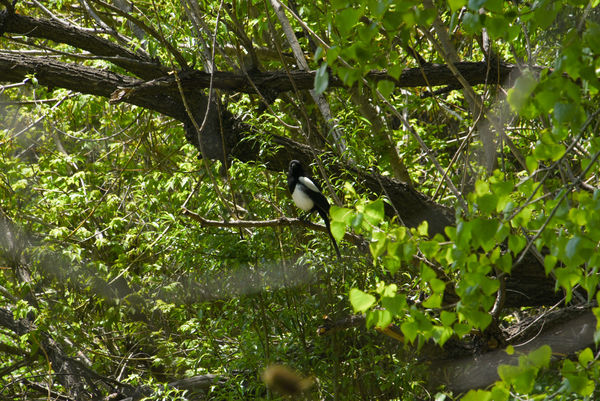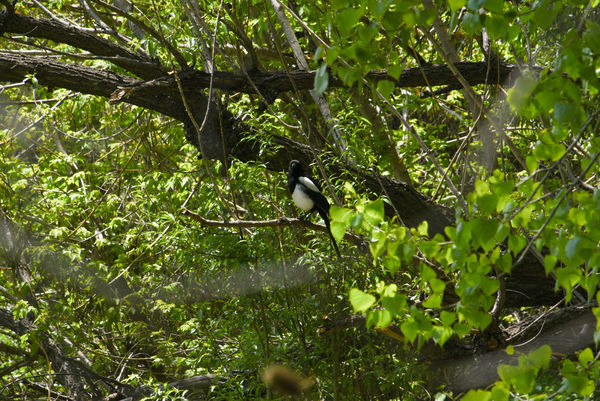Strange bokeh
Jun 2, 2019 13:05:15 #
Timmers wrote:
What follows is why so many on the Hog Forum regar... (show quote)
I do not (thankfully) recall seeing you on here prior to this but I can understand why you believe you have a reputation here.
I find your rather pedantic explanation to be misleading. The cause of the distortion is obviously the result of transcendental forces tossing a metaphysical pebble into the pool of a failed reality.
Jun 2, 2019 13:11:47 #
Jun 2, 2019 13:12:34 #
R.G. wrote:
That's an interesting suggestion but I don't see how foreground stuff could produce the circle of ripples AND the outlying ripples as well. However, there are a couple of blurry, light, long curving lines in the bottom left corner (going left and up from the bottom of the guttering) which may have been produced by intervening cables or some such.
I am not basing my hypothesis on any technical theory that can only be determined in optical bench or laboratory methodologies and controlled environments. Whether it is a form of diffraction, a forced aberration caused by interference or other unknown effect caused by any number of optical phenomena or something unique to the environment in the OP particular shot, is anyone's guess or at least an educated guess.
In my own experience, however, I have seen this kind of effect and many others for which I have no theoretical explanation but nonetheless, are not distracting or detriment to any given image. Some are actually interesting, aesthetically pleasing and I have learned to call upon them and apply them as needed.
When bokeh or selective focus is discussed, oftentimes foreground elements are not part of the conversations nor are the effects or affectations of their presence in the scene.
The OPs question suggests to me that he finds some abnormality in the "bokeh". My question is what does "bokeh" supposed to look like- is there some preconceived idea of what shape or configuration all the out of focus elements are supposed to appear as. Perhaps this effect as shown is serendipitous to the scene, the lightning physical conditions of that scene at that moment and will never recur again. There may be some aspect of the lens design that brings this on under certain conditions.
I get the feeling that some photographers envision good "bokeh" as some kind of uniform special effect or repeatable look that can be added in during post-processing from a fixed app. It would be costly for the OP to send his equipment in for costly diagnosis and repair unless there is some recurring anomaly or some artifactual defect in the lens that is affecting all of his images. This could simply be a one-off occurrence.
My suggestion was simply to replicate the lighting, exposure and focus components and introduce some controlled interference and observe the results.
Jun 2, 2019 13:19:42 #
nadelewitz
Loc: Ithaca NY
rook2c4 wrote:
You absolutely nailed it with your explanation.
To simplify the general concept - foreground bokeh pattern interacting with background bokeh pattern, creating a secondary pattern (in this case, the ripple effect).
Unfortunately, there are UHH members who will continue to insist the lens is defective and it needs to be replaced.
To simplify the general concept - foreground bokeh pattern interacting with background bokeh pattern, creating a secondary pattern (in this case, the ripple effect).
Unfortunately, there are UHH members who will continue to insist the lens is defective and it needs to be replaced.
Difficult to conceive of a lens defect that would produce the aberration shown.
Jun 2, 2019 13:46:19 #
jerryc41 wrote:
Wow! I have the same lens, but I've never seen that.
............
Wow! I have the same lens, but I've never seen that.
............
I also use that lens. Never a similar effect.
You certainly seem to have an optical flaw.
I'm not among the "Bokeh Cult" ... I even
see it as quite ridiculous, but what you've
posted is not "lousy bokeh" but rather is
likely evidence of an actual problem.
If you can replicate the effect, especially
on a tripod and using Live View, then set
the camera to "shoot without lens", then
unlatch the lens lock and rotate the lens
in the mount to see if the effect rotates
across the view as you rotate the lens. If
so, you have confirmation.
OTOH, if the effect does NOT rotate with
the lens, you just happened to record a
very weird phenomenon ... which I very
much happen to doubt is the case :-(
--------------------------------------------
BTW, if you cannot operate the Live View
with the lens unlatched and rotated, you
could test by zooming. If the effect is in
the nature of the scene and thus not due
to optics, then zooming will only enlarge
or shrink the whole image but WILL NOT
move the effect relative to any objects in
the subject scene.
If it's an optical effect, it might grow or
shrink when zooming, but the center of
the effect should not relocate relative to
a fixed object in the scene.
Jun 2, 2019 14:04:34 #
fantom wrote:
..........
The cause of the distortion is obviously the
result of transcendental forces tossing a
metaphysical pebble into the pool of a failed
reality.
The cause of the distortion is obviously the
result of transcendental forces tossing a
metaphysical pebble into the pool of a failed
reality.
... like WORM HOLE ? Or a miniaure Star
Ship passing thru, and the exhaust from
its Warp Engines is distorting gravity and
space/time ? I thought Nikon's Advanced
Integrated Optical Lens Coatings protect
against that stuff .....
.
Jun 2, 2019 14:50:41 #
GregoryF
Loc: Bella Vista, AR
fantom wrote:
I do not (thankfully) recall seeing you on here prior to this but I can understand why you believe you have a reputation here.
I find your rather pedantic explanation to be misleading. The cause of the distortion is obviously the result of transcendental forces tossing a metaphysical pebble into the pool of a failed reality.
I find your rather pedantic explanation to be misleading. The cause of the distortion is obviously the result of transcendental forces tossing a metaphysical pebble into the pool of a failed reality.







Jun 2, 2019 15:05:37 #
R.G. wrote:
That's an interesting suggestion but I don't see how foreground stuff could produce the circle of ripples AND the outlying ripples as well. However, there are a couple of blurry, light, long curving lines in the bottom left corner (going left and up from the bottom of the guttering) which may have been produced by intervening cables or some such.
It is entirely possible for OOF foreground objects to create the kind of disturbance seen here. That is by far the most likely explanation, which is why I suggested shooting some other subjects. I find it highly unlikely than any lens fault could produce that ripple effect--it would certainly also affect the sharpness of the subject in that area if it were something with the lens. One possibility (though doubtful) is something inside the lens itself, but that would be clearly visible looking through the lens.
Jun 2, 2019 15:06:31 #
I am puzzled by the two ripples too. There is one in front of the bird, clearly obvious. The second ripple in the upper left hand corner is not as obvious. It may be a one time variant that is unexplainable by any of us Hoggers. It could be a smudge of some sort on the lens either externally or heaven forbid internally. It could be a particle of some sort between the lens and the sensor. You may want to have it serviced or replaced. I'm familiar with the Fibonacci principle but this doesn't seem the cause. I could be wrong about this as I'm not an expert. As for any Hogger to criticize or insult another Hogger that is inappropriate. No one of us is better than another.
Since the lens is under warranty it is better to return this lens to the manufacturer with a copy of the photo
Since the lens is under warranty it is better to return this lens to the manufacturer with a copy of the photo
Jun 2, 2019 15:50:51 #
I have that lens and have never gotten an image like your example. I would try several similar shots and several different shots and compare. If it's consistent, call Nikon. If it's a one of kind ignore it.
Jun 2, 2019 16:13:52 #
E.L.. Shapiro wrote:
I am not basing my hypothesis on any technical the... (show quote)
Your posts would not fly on a science forum. But, this is a photography forum and you speak a language I understand.
Thank You!
--
Jun 2, 2019 16:17:06 #
Timmers wrote:
What follows is why so many on the Hog Forum regar... (show quote)
That was a fascinating explanation.
Jun 2, 2019 17:28:42 #
Could the problem be similar to the phenomena depicted in this picture? Notice three twigs that are in the foreground at two, five and nine o'clock that appear to be translucent. The wind wasn't blowing by any noticeable amount and the shutter speed was 1/250.
I've checked store original but "Download" does not appear so if it is not there when I send it I will resend. I was shooting RAW and jpg that day and this is the jpg straight out of the camera.
What caused the twigs to only partially obscure the focus points?
I've checked store original but "Download" does not appear so if it is not there when I send it I will resend. I was shooting RAW and jpg that day and this is the jpg straight out of the camera.
What caused the twigs to only partially obscure the focus points?

Jun 2, 2019 17:31:45 #
fantom wrote:
Could the problem be similar to the phenomena depi... (show quote)
Here's the pic with store original checked.
Jun 2, 2019 18:28:37 #
My question to the OP is, where were you shooting from?
The bird is standing on the corner of a rain gutter. It looks like you were almost on the same level as the bird or a little below it.
Did you shoot this from an upper room thru glass?
The bird is standing on the corner of a rain gutter. It looks like you were almost on the same level as the bird or a little below it.
Did you shoot this from an upper room thru glass?
If you want to reply, then register here. Registration is free and your account is created instantly, so you can post right away.









